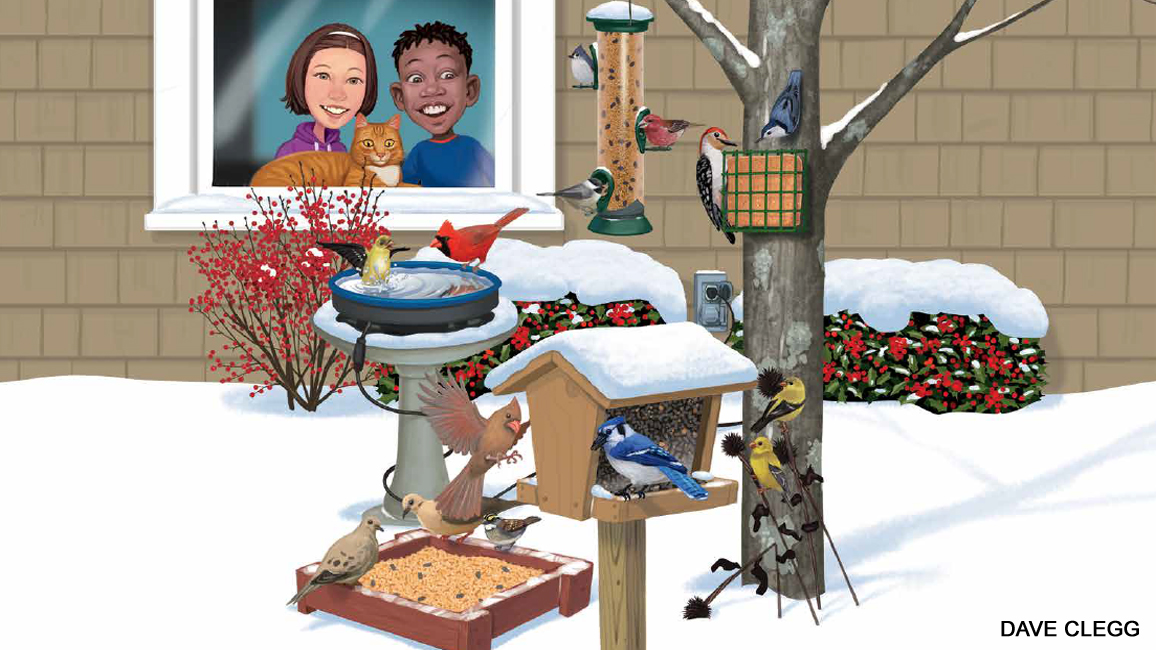
Winter Is for the Birds
By Ellen Lambeth; Art by Dave CleggFill your feeders to support your local feathered friends!

Not all the birds in your area migrate (move away) for the winter. Some stick around all year. And others move in from other places.
It may be cold and snowy where you live. But birds still find seeds, grains, nuts, and berries on winter plants. Or they peck away for creepy-crawlies hiding under tree bark or in other protected places. And birds of prey swoop down on small animals that are out and about looking for food themselves.
Even though winter birds can usually get by just fine on their own, some people give them a break by putting out feeders and keeping them filled. Many birds drop in for the free treats. And the people get to enjoy the live show through their windows. You can make your own backyard show, too!
WHERE TO FEED
Some birds find their food on the ground. Some look for food while clinging to and creeping along tree trunks or branches. And some prefer to perch and peck. So it makes sense that different types of feeders attract different kinds of birds. Here are some common ones:
1. A tray feeder is great for ground-feeders such as doves, sparrows, and juncos.
2. Chickadees, finches, and titmice will often flock to a tube feeder.
3. A hopper feeder attracts birds such as cardinals, grosbeaks, and jays.
4. Woodpeckers and nuthatches are common visitors at a suet feeder. (See recipe below.)
WHAT TO FEED
You can’t go wrong with seed! Bird stores, feed stores, garden stores, and even grocery stores carry bird seeds of all kinds. Many sell seed mixes, but you might want to use a single type in each feeder. Probably the most popular bird food is black-oil sunflower seeds. Lots of birds go for those, as well as safflower seeds (which squirrels don’t like). Finches like nyjer seeds (sometimes called “thistle”). Ground-feeders go for cracked corn or millet. One high-energy food is suet (SOO-it), which is beef fat that may be available at your grocer’s meat department. Insect-eaters especially love it, and it helps birds stay warm in winter.

FEEDING TIPS
- Be patient. If you’re just getting started, the birds might not come right away. Give them time to find your feeders. Once one or two show up, others will follow.
- Keep cats away. Free-roaming cats will think a feeding station is a good place to stalk. Leave them inside.
- Avoid crashes. Place feeders either right against windows or far enough away that birds don’t slam into them if they have to scatter quickly.
- Consider cover. Trees or shrubs near feeders offer birds protection, in case of icy wind gusts or incoming predators.
- Don’t forget water! A heated birdbath will keep water from freezing. Or just remove any ice that forms and refill with fresh water daily.
- Feeders and birdbaths can spread bird diseases. Bring them in to clean every couple of weeks.
- Outsmart the squirrels. That’s easier said than done! Squirrels love to raid feeders, even ones that claim to be squirrel-proof. If you were a squirrel, how successful would you be at raiding a feeder? Test your skills by playing this game:
rangerrick.org/birdfeeder
FEEDING FUN
- Make your own winter treat. Ready-made suet cakes are available at stores. You might also try this easy recipe: With an adult’s help, melt 1 pound (2 cups) of suet or lard with 1 cup of natural peanut butter in a pot on low heat. Stir in 2 cups of yellow cornmeal. If you like, you can also stir in some bird seed. When the mixture has cooled down, you can use it to stuff into pine cones to hang up. Or spread it into pans or molds and let harden overnight in the refrigerator. Then pop out the shapes and hang them outside.
- Decorate for the birds. Use your hands to poke, punch, or draw patterns in the snow’s surface. Then sprinkle in seeds of different kinds and colors to form pictures or designs. Later on, watch from inside as the birds thankfully destroy your artwork!
- Landscape your yard to be bird-friendly. Next spring or summer, plant flowers, shrubs, and trees that provide food in winter and throughout the year. A local garden center can help your family choose the best plants for your area. Or your family can visit
nwf.org/gardenforwildlife. - Share your news! Scientists at Project FeederWatch would like to know about your feathered guests. The information you provide helps them find out how different kinds of birds in different places are doing from year to year. It also helps you keep track of changes in your own yard. For more, you and your family can visit feederwatch.org. This website also provides lots of helpful information. For example, click on “Common Feeder Birds” under “More to Explore” to discover what birds you’ll find in your area and what feeders and food they prefer.
















